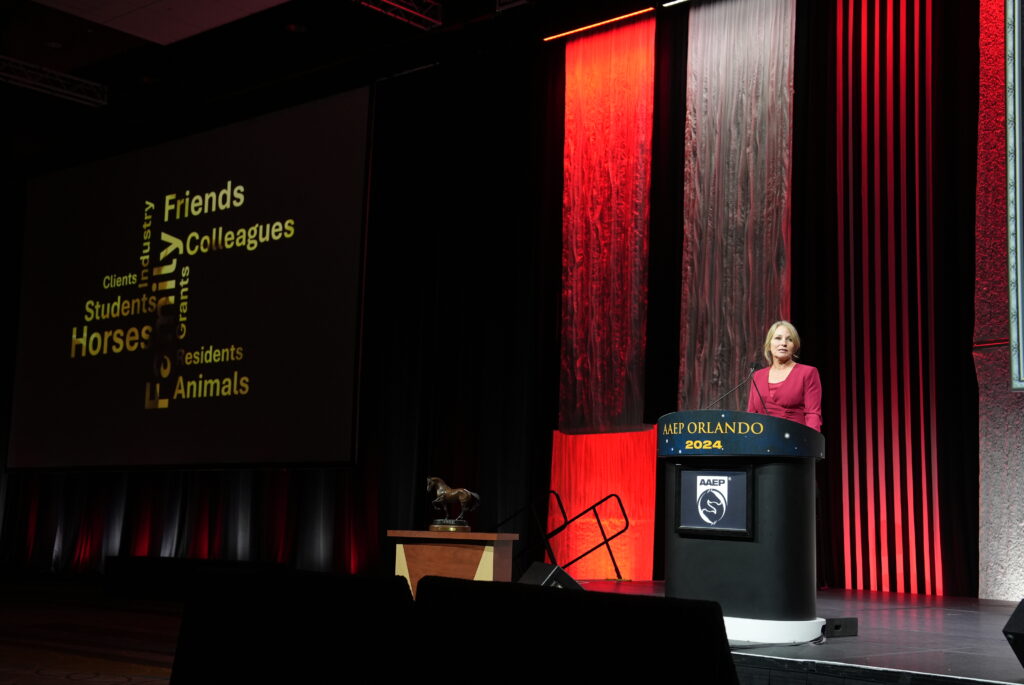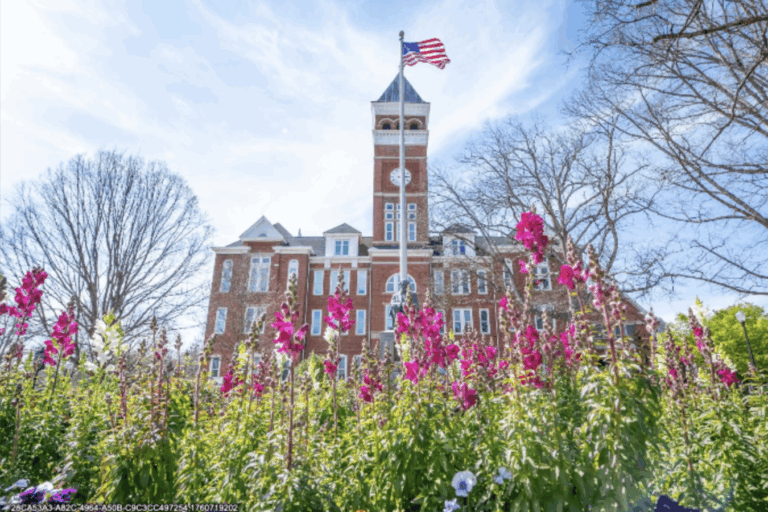This article originally appeared in the Spring 2025 issue of EquiManagement. Sign up here for a FREE subscription to EquiManagement’s quarterly digital or print magazine and any special issues.

Be it trail riding, friendly competition, or elite equestrian sport, some degree of lameness due to joint pain or soft-tissue injury is inevitable for many equine athletes. Decades of research have led Lisa Fortier, DVM, PhD, DACVS, to a lameness treatment plan that “capitalizes on the patient’s own ability for healing.” Fortier, the James Law Professor of Surgery at Cornell University College of Veterinary Medicine, has dedicated her career to musculoskeletal research and is a leader in the field of orthobiologics. Fortier was the 28th presenter of the Milne Lecture at the 2024 American Association of Equine Practitioner’s Convention and entertained the audience with her journey from the whispers of the regenerative medicine concept to the widespread clinical application of orthobiologics for restoring biological function.
Exposing Science’s Flaws
Fortier was first introduced to the concept of regenerative medicine in the 1990s. Then, scientists were starting to look at using tissue engineering to restore function to injured tissues and organs. They knew they needed a trilogy of “ingredients” if they were going to successfully regenerate tissue, including a scaffold, bioactive signals, and cells. By the early 2000s, a subspecialty of regenerative therapy called orthobiologics was born, which Fortier found alluring because it promised to use the patient’s natural healing powers to effectuate repair in musculoskeletal tissues.
“Early research in this field, however, quickly exposed our lack of basic understanding of tissue regeneration and repair,” Fortier relayed.
The equine community forged ahead, and aggressive research efforts resulted in three main orthobiologics becoming increasingly available and embraced autologous conditioned serum (ACS, interleukin-1 receptor agonist protein, IL-1Ra, or IRAP), platelet-rich plasma (PRP), and bone-marrow cultured-derived mesenchymal stem cells (MSCs).
Bringing Attention to ACS
To produce ACS, blood samples collected from the patient are incubated with glass beads, and the macrophages binding to the beads produce IL-1Ra.
In 2014, researchers evaluated a single intra-articular injection of ACS without incubating the blood sample overnight. They found this technique still produces IRAP, but other studies found that bone marrow concentrate contained more IL-1Ra than IRAP does.
“All these biologics are complex. There are a lot of different cells in IRAP, and they change between horses,” said Fortier. “None of these are miracle drugs.”
She also recommends using IL-1Ra as a first- not last-line therapy. “We want to treat acute joints when there is lots of IL-1 present. We want to give IRAP at Time 0 then follow up with either IRAP or a hydrogel,” said Fortier.
And despite the popularity of ACS/IRAP, surprisingly little data exist regarding its clinical use. A recently published systematic review included six studies on IRAP, but only one included a control group (Della Tommasa et al. 2023).
“Clinical trials are exceptionally difficult to successfully execute, resulting in one of the greatest hurdles in our attempts to optimize joint therapy,” Fortier said.
Peeking at PRP
PRP was introduced about the same time as IRAP and in equine medicine is primarily used for tendons. PRP was originally defined as centrifuged blood that contains five times more platelets than blood, but otherwise has no real definition.
“The mantra was that platelets contain growth factors, and if ‘some’ is good, ‘more’ is better. As a result, the industry went crazy trying to figure out how to get the most platelets,” said Fortier.
The first big transformation in generating and understanding PRP occurred around 2010, and it was a game-changer.
“We performed complete blood cell counts (CBCs) on PRP to verify the platelet count,” Fortier explained. “A reviewer of that study asked whether platelet count might be related to outcome. We instead found that white blood cells negatively affected matrix synthesis and increased matrix degeneration.”
Emily Sundman, DVM, DABVP, next found that IL-1β has a positive correlation with neutrophils.
“The perfect PRP is one that is leukoreduced but that retains monocytes. Watch for this in the future,” Fortier said.
Fortier said she injects PRP using ultrasound guidance, being careful not to overfill the lesion. She combines this with either shock wave or MagnaWave. At the same time, she draws bone marrow to send for stem cell culture. If she gets no response to this treatment, defined as a 50% improvement in lameness, she does not perform a second injection—it’s either too late or the diagnosis is wrong.
“If there is a response in two weeks, repeat the injection,” she said. “But I almost never do a third injection of PRP. Instead, I use cultured stem cells or a 2.5% hydrogel.”
Lesions must be treated during the acute phase of injury. “Don’t waste your money trying to treat something old—the biologics won’t work,” said Fortier.
Concentrating on BMC
According to Fortier, bone marrow concentrate (BMC) is somewhat like PRP in that the bone marrow is collected and centrifuged. BMC contains all the requisite ingredients for tissue regeneration, including stem cells, macrophages, and lots of cytokines and growth factors, and it has a scaffold. In fact, BMC is pretty much PRP with a few stem cells and a lot of IRAP.
“This is the best of the biologics for tissue repair. One of the best biologics we have,” said Fortier.
Researchers studied PRP and BMC’s efficacy in 92 horses and found BMC was superior to leukocyte-reduced PRP for primarily the high forelimb suspensory.
Fortier provided an example of treating a high suspensory injury by administering BMC via ultrasound guidance and shock wave/MagnaWave for six weeks, combined with corrective shoeing and rehabilitation.
“The majority of horses returned to previous level of performance compared to those with the same rehabilitation program but without BMC treatment,” she said.
One of the primary uses of BMC, though, is subchondral bone cysts during arthroscopic surgery.
Moving Into MSCs
“How do MSCs work? We still don’t know. The old, old way of thinking is that they ‘turn into’ a tissue type,” said Fortier. “We now know this is not true. Instead, they secrete bioactive factors that make the tissues around it happier, promote angiogenesis, and recruit other cells.”
An important point made by Fortier was to use autologous MSCs. Allogeneic MSCs induce an immune response; they are not immunoprivileged. If you must use allogeneic (e.g., an “off-the-shelf” product in the acute stage of disease), it’s probably safest to only use it once.
“There can be a massive immune response following a second injection. I have lost two horses because of this,” she warned.
Fortier shared data showing that Thoroughbreds have decreased risk of reinjury when treated with MSCs, highlighting the work of Roger Smith, MA, VetMB, PhD, DEO, DECVSMR, DECVS, FRCVS. She said these findings “set the world on fire.”
“There is convincing evidence from several studies that MSCs are an effective treatment for bowed tendons,” she added.
Take-Home Message
Fortier encouraged all veterinarians to keep meticulous records so data can begin “answering some of the unanswered questions and improve outcomes for our equine athletes.”
She also emphasized the importance of treating horses with orthobiologics in the acute phase of injury and combining orthobiologics with rehabilitation exercise.
Be cognizant of the horse’s health. Today, many horses have a subtle, underlying endocrine abnormality such as insulin dysregulation or pituitary pars intermedia dysfunction. Fortier said she believes every horse should have a screening test for endocrine disorders, as these horses are at risk of musculoskeletal injury and have impaired regenerative capacity.
Related Reading
- 2024 AAEP Convention Research Highlights
- 2024 AAEP Convention Business Highlights
- Healing With Horsepower: Recent Orthobiologics Research
Stay in the know! Sign up for EquiManagement’s FREE weekly newsletters to get the latest equine research, disease alerts, and vet practice updates delivered straight to your inbox.




